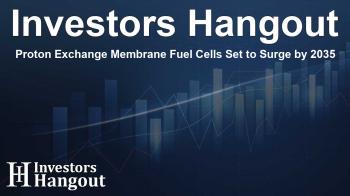Proton Exchange Membrane Fuel Cells Set to Surge by 2035

Proton Exchange Membrane Hydrogen Fuel Cell Market Overview
The global proton exchange membrane hydrogen fuel cell market is undergoing remarkable growth, with projections estimating an increase from approximately US$ 3,955.6 million in 2024 to an impressive US$ 13,163.4 million by 2035. This represents a robust compound annual growth rate (CAGR) of 11.9%. As we delve into this market, we'll explore the primary factors driving this expansion and the key players involved.
Growth Projections and Market Dynamics
The past few years have seen a steady rise in the adoption of PEM fuel cells, underscoring their potential in various applications, from automotive to stationary power generation. The market is projected to create an absolute value opportunity of US$ 8,887.1 million during the period of 2025 to 2035. This growth can be attributed to several factors, including increasing environmental awareness, government initiatives towards sustainability, and technological advancements that enhance fuel cell efficiency.
Key Factors Influencing Market Growth
One of the significant drivers for the market is the surge in the adoption of environmentally friendly technologies across various industries. As industries strive for greener options, PEM fuel cells present a viable solution. They operate at high efficiency and produce only water vapor as a byproduct, making them an attractive choice for manufacturers focused on reducing their carbon footprints.
Regional Insights and Market Share
While the global landscape for proton exchange membrane hydrogen fuel cells is promising, North America is expected to capture a substantial market share by 2035. Analysts predict that this region will hold approximately 3% of the overall market. Furthermore, regions such as East Asia are projected to also see considerable growth, driven by their investments in hydrogen infrastructure and technological developments in fuel cell technology.
Leading Companies Shaping the Future
Several market players are pivotal in driving innovation in this sector, including:
- Air Liquide Energies
- Ballard Power Systems
- Cummins
- Doosan Fuel Cell
- Horizon Fuel Cell Technologies
- Hydrogenics
- Hyundai Motor Company
- Nedstack Fuel Cell Technology
- Nuvera Fuel Cells
- Panasonic Corporation
- Plug Power
- Robert Bosch
- SFC Energy
- TW Horizon Fuel Cell Technologies
These companies are not only competing for market share but are also collaborating with leading research institutions to advance fuel cell technology. For example, partnerships are emerging to focus on research that enhances the efficiency and durability of PEM fuel cells.
Technological Advancements and Future Outlook
Innovations in PEM fuel cell technology are crucial for the sector's sustained growth. Enhancements in the design and materials used in fuel cells contribute to improved performance, making them more applicable across a variety of sectors. Additionally, the expansion of hydrogen production and refueling infrastructure is critical in supporting market growth.
Industry Milestones and Innovations
Recent industry developments highlight the sector's progress. Notably, the announcement of Cummins' launch of its first e-compressor for fuel cell engines marks a significant step forward in fuel cell technology. This product, tailored for various fuel cell engine capabilities, emphasizes the growing focus on high-efficiency components in the fuel cell supply chain.
Environmental Impact and Future Demand
With an increasing push for net-zero emissions worldwide, the demand for hydrogen fuel cells is anticipated to surge. The European Union's commitment to achieving net-zero emissions by 2050, coupled with strategic partnerships focused on fuel cell integration, indicates a robust market outlook for proton exchange membrane hydrogen fuel cells.
Frequently Asked Questions
What is the projected growth rate of the proton exchange membrane fuel cell market?
The market is expected to grow at a CAGR of 11.9%, reaching US$ 13,163.4 million by 2035.
Which regions are leading in the adoption of PEM fuel cells?
North America and East Asia are anticipated to be key regions driving the growth of the PEM fuel cell market.
What are the primary applications for PEM fuel cells?
PEM fuel cells are widely used in automotive applications, stationary power systems, and portable power solutions.
Who are the major players in the PEM fuel cell industry?
Major companies include Air Liquide Energies, Ballard Power Systems, Cummins, and Plug Power, among others.
What impact do technological advancements have on PEM fuel cells?
Technological improvements enhance the efficiency, durability, and overall appeal of PEM fuel cells, contributing to their widespread adoption.
About The Author
Contact Hannah Lewis privately here. Or send an email with ATTN: Hannah Lewis as the subject to contact@investorshangout.com.
About Investors Hangout
Investors Hangout is a leading online stock forum for financial discussion and learning, offering a wide range of free tools and resources. It draws in traders of all levels, who exchange market knowledge, investigate trading tactics, and keep an eye on industry developments in real time. Featuring financial articles, stock message boards, quotes, charts, company profiles, and live news updates. Through cooperative learning and a wealth of informational resources, it helps users from novices creating their first portfolios to experts honing their techniques. Join Investors Hangout today: https://investorshangout.com/
The content of this article is based on factual, publicly available information and does not represent legal, financial, or investment advice. Investors Hangout does not offer financial advice, and the author is not a licensed financial advisor. Consult a qualified advisor before making any financial or investment decisions based on this article. This article should not be considered advice to purchase, sell, or hold any securities or other investments. If any of the material provided here is inaccurate, please contact us for corrections.

